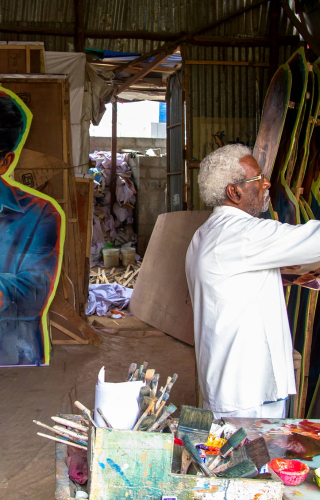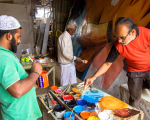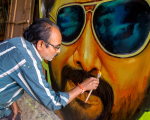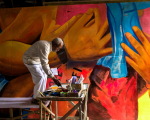In the Cooch Behar of the late 1980s, I used to pass two single-screen theatres on my way to school. Behind one of those was a shop, where the owner, Babuda, used to paint movie posters for Friday releases. It would be either ‘Kaka babu’ Rajesh Khanna and ‘Dreamgirl’ Hema Malini striking a dance pose, or local boy Mithunda punching some bad guys. The posters were kitschy, colourful and flamboyant. By the time I entered college in the 1990s, hand-painted film posters were already on the decline. Like Babuda, most poster painters had either retired or switched to other professions to make ends meet.
Years later, when I started working in Bangalore, I discovered larger-than-life movie posters on Kempe Gowda (K.G) Road, which was once the hub of cinema culture in Bangalore. While many of the iconic theatres and cinema halls have either shut down or have been demolished, some single-screen theatres such as Triveni, Santosh and Movie Land still stand in the area. I was struck by the kaleidoscope of heroism, action and melodrama these posters conveyed. My childhood curiosity was rekindled; after a few visits to these surviving theatres and talking to some local movie enthusiasts, I stumbled upon Rajkamal Art Studio in Mahalakshmi Layout. Rajkamal Art Studio is probably the only studio in Bangalore still making gigantic hand-painted cutouts of actor and politicians. The single-room studio was started by Kakaiati Chinnappa in 1972.
When I reached there, I found K Chinnappa busy giving the final coat on a 40-feet-tall cutout of actor Shiva Rajkumar. After five decades of being a professional painter, today Chinnappa has more than 4,500 film banners and cut-out paintings to his credit. In his long career, he has illustrated every major South Indian movie star and even some Hollywood actors like Arnold Schwarzenegger, Sylvester Stallone and Jackie Chan. Chinappa’s son, Gopalakrishna, was busy giving instructions to a truck driver about the 12 locations where these posters needed to be installed. Thursdays are the busiest, with a film release the next day.
Chinnappa is over 80 years old now. He started painting at the age of nine and apprenticed under S.K. Seenu, a banner artist of great repute himself. Chinappa recalls the iconic poster of Mother India (1957) in which late actress Nargis is seen carrying a plough on her shoulders. The challenge was to portray the burden she was carrying on her shoulder with the emotional exhaustion on her face. When Bobby released in 1973, the legendary Raj Kapoor (director and producer of the film) was so impressed by the film banner, he took photographs of them. Chinnappa also showed me gifts he had received from Kannada cinema superstar Dr Raj Kumar for the exceptional banner work for his movies Naa Ninna Mareyalaare and Sanaadi Appanna. Along with movie stars, Chinnappa has also received orders for life-size paintings of many prominent politicians. He recently painted a 46-feet cut-out of current prime minister, Narendra Modi.
However, Chinnappa is well aware that digital technology and advanced software—easier, quicker and cheaper than hand-painted posters—have made the paintbrush redundant. The industrial demand for hand-painted posters is almost gone now. Still, there is no dearth of pride in Chinnappa’s voice when he talks about his work. ‘There is no substitute to hand-painted posters when it comes to conveying raw emotions and energy to the audience. It is almost equivalent to a handwritten love letter. Keep a digital print next to a hand-painted poster and you will find a rich texture of colours and contours in the poster which is missing in a flat digital print,’ he says.
Outside Rajkamal Art Studio, hand-painted posters have found another small but niche market in Bangalore. Anyone who has taken an autorickshaw ride in the city would have seen Salman Khan with his muscular biceps, the long-haired Sanjay Dutt, or ‘Thalaivar’ Rajinikanth painted on the vehicles. Noticing these, and curious to know how they are made, I resumed my search again; but this time the artist was harder to locate. I only knew the name of the painter—N. Naseer—from a tiny signature on one of his artworks. Finally, an autorickshaw driver took me to a bylane on Magadi Road, where I found Naseer in his small studio.
Now 40, Naseer has been painting since he was 12. He is in much demand as an artist. It takes him a month to execute a project once it has been commissioned. The painting is done on adhesive-backed vinyl sheets with plastic paints. The paintings call for the kind of skill and attention to detail that we associate with miniatures. Thin brushes are used to portray minute facial features and expressions. Once the painting is done, varnish is sprayed on it to make the painting waterproof and durable. The sticker is then removed and pasted on the autorickshaw, wherever the owner/driver wants. The rest of the artwork, which includes writing the names of the owner/driver and the movie stars, and other ornamentation work, is done by hand directly on the autorickshaw. The entire process, once started, takes two to three days; the cost of each painting is around Rs 2,500 but can go higher, depending on the detailing involved. However, drivers are willing to pay because these artworks give their vehicles a distinct identity. Other than highlighting the images of their idols prominently, Naseer also puts the names of the drivers on the vehicles.
This art practice too is gradually heading towards extinction. Most auto drivers now opt for digitally printed stickers instead of manual paintings. Stickers take less time and money. However, like Chinnappa’s undying love for hand-painted movie posters, Naseer too is married to his passion. He feels that despite the dwindling popularity there will always be people who are actual connoisseurs of the art. As long as movie stars and politicians hold demi-god status in southern India’s socio-cultural landscape, there will be demand for hand-painted posters matching their aura.

















